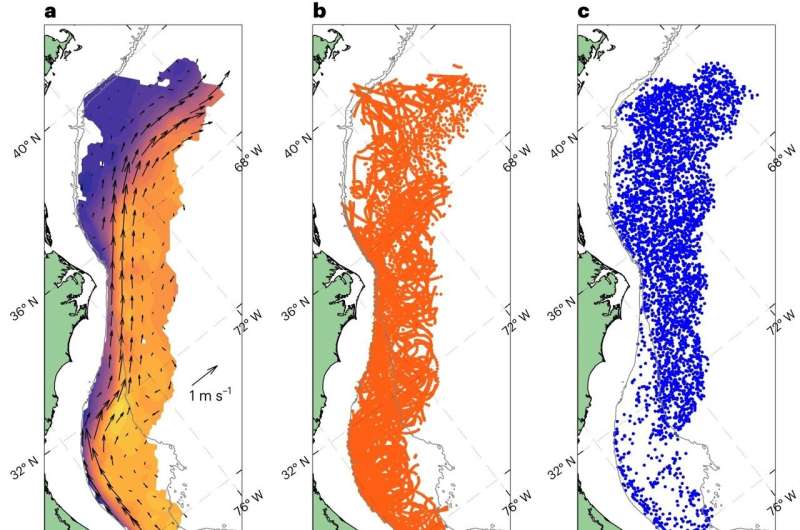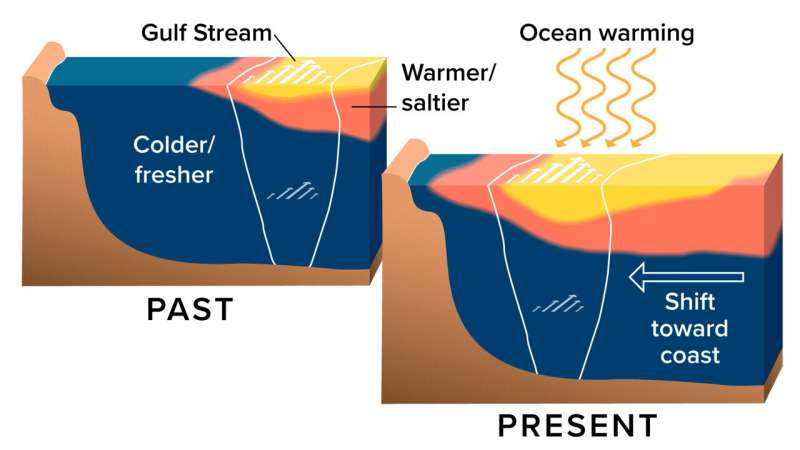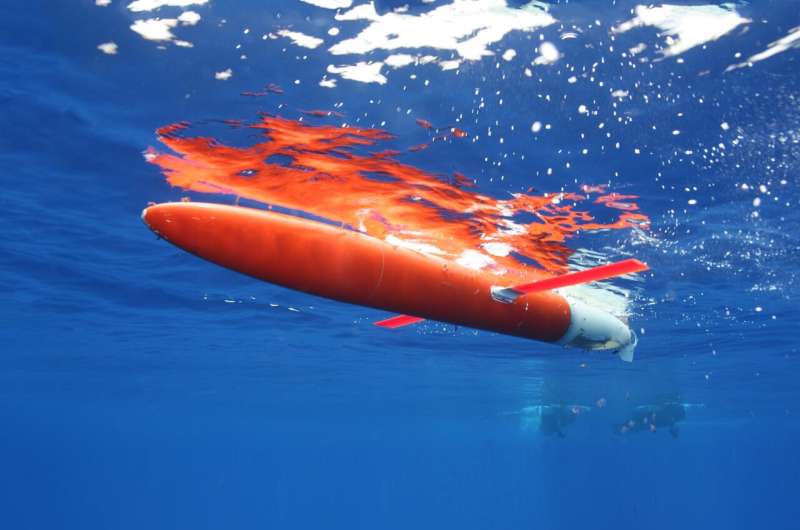This article has been reviewed according to Science X's editorial process and policies. Editors have highlighted the following attributes while ensuring the content's credibility:
fact-checked
peer-reviewed publication
trusted source
proofread
New study finds that the Gulf Stream is warming and shifting closer to shore

The Gulf Stream is intrinsic to the global climate system, bringing warm waters from the Caribbean up the East Coast of the United States. As it flows along the coast and then across the Atlantic Ocean, this powerful ocean current influences weather patterns and storms, and it carries heat from the tropics to higher latitudes as part of the Atlantic Meridional Overturning Circulation.
A new study published today in Nature Climate Change now documents that over the past 20 years, the Gulf Stream has warmed faster than the global ocean as a whole and has shifted towards the coast. The study, led by Robert Todd, a physical oceanographer at the Woods Hole Oceanographic Institution (WHOI), relies on over 25,000 temperature and salinity profiles collected between 2001 and 2023.
"The warming we see near the Gulf Stream is due to two combined effects. One is that the ocean is absorbing excess heat from the atmosphere as the climate warms," said Todd. "The second is that the Gulf Stream itself is gradually shifting towards the coast."
He and study co-author Alice Ren, also a physical oceanographer at WHOI, found that the near-surface layer of the Gulf Stream has changed most prominently. According to their data, it has warmed on average by about 1°C (1.8 °F) over the past two decades, becoming increasingly lighter than the waters below. The team also found the Gulf Stream to be shifting closer to the shore by about 5 kilometers (3.1 miles) per decade on average, meaning that the Gulf Stream is moving gradually closer to the Northeastern United States continental shelf.
"One of the triumphs of this paper is that it provides observational confirmation of something that numerical simulations have predicted in a warming climate," Todd said.
They identified these trends using observational data from Spray autonomous underwater gliders and from the Argo Program, which is an array of about 4,000 autonomous profiling floats that drift with ocean currents and move up and down between the surface and about 2,000 meters (6,560 feet) in depth, collecting data as they rise. Argo is an international program that has been operating since 1999. WHOI is one of the original Argo institutions and maintains about 10% of the array.

To better resolve the Gulf Stream, Todd and Ren have launched Spray gliders off the coast of Florida every two months. Like Argo floats, the gliders move up and down, but they have the additional ability to fly through the water and crisscross the Gulf Stream as it carries them northward. By providing measurements below the surface of the Gulf Stream, the gliders and floats complement satellites that routinely measure water temperature at the ocean surface.
"It can be difficult to make predictions about a current like the Gulf Stream using numerical modeling," said Ren. "Our paper is important in that it provides observational details about our changing weather and changing climate."
Just like the jet stream in the atmosphere, the Gulf Stream sways and oscillates within the ocean. With its average position getting closer to the coast, Todd pointed out that those large oscillations could more easily and suddenly influence coastal fisheries—for example, water temperature could go from 12°C to 20°C in a very short period of time.

Ocean temperatures are steadily getting warmer as a result of human activities, such as burning fossil fuels, releasing heat-trapping greenhouse gases into the atmosphere. However, the basic drivers of the Gulf Stream—atmospheric wind patterns and the Earth's rotation—will not disappear in a changing climate, so there is no concern that the Gulf Stream will shut down.
"That's not to say that it won't shift or change its strength, but those basic ingredients are all it takes to have a warm, fast Gulf Stream flowing along the U.S. East Coast," said Todd.
More information: Robert E. Todd et al, Warming and lateral shift of the Gulf Stream from in situ observations since 2001, Nature Climate Change (2023). DOI: 10.1038/s41558-023-01835-w
Journal information: Nature Climate Change
Provided by Woods Hole Oceanographic Institution




















